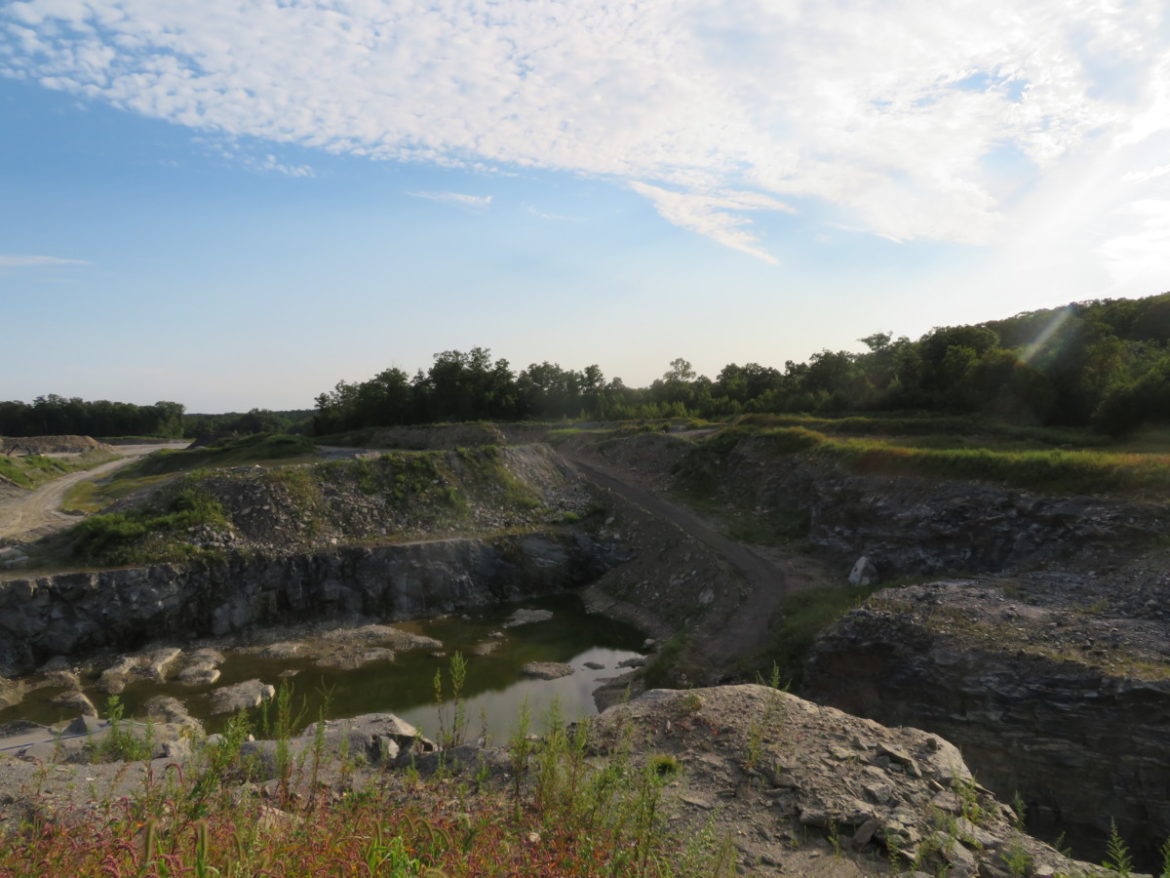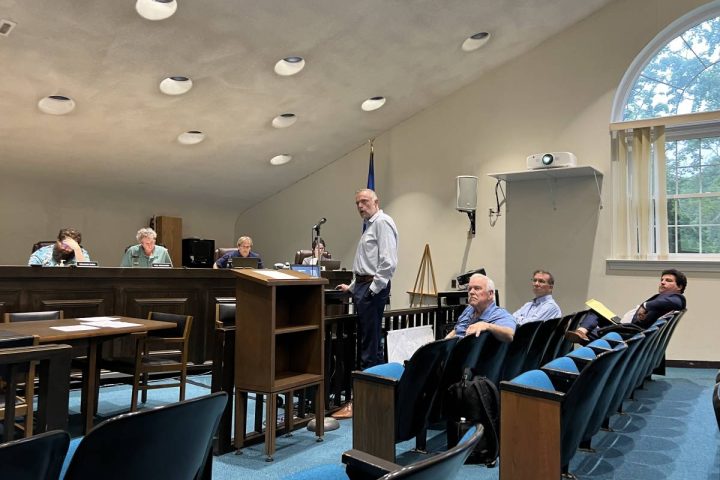MONROE, CT — A Planning and Zoning Commission hearing on a proposal to restore wetlands, construct a small office building and fill in a huge hole on industrial land in the Pepper Street Business Park was marked by bickering among representatives of the applicant and the neighboring property owner, who has intervenor status to participate in the proceedings.
During Thursday’s hearing, Attorney Joel Z. Green, who represents the intervenor, Peter Metropoulos, recalled how Kevin Solli, the engineer for the applicant, tried to put commissioners at ease over testing procedures of fill material being trucked to the site.
But Green said his client, who has concerns over the project and its potential impact on groundwater and the environment, does not feel comfortable.
The property at 64 Cambridge and 4 Independence drives had been used for an illegal rock crushing operation before it was purchased in May of 2019 by Astro Land Holdings LLC and Spacely Land Holdings LLC.
Green said hiring Solli Engineering was one of the first things the new owners did.
“I’ve seen surveys from Mr. Solli’s firm from 2013, 2015 and 2018 of this site,” Green said. “While this site was being wounded, Mr. Solli’s firm surveyed and didn’t come forward and raise any alarm … so I don’t take comfort in that.”
Solli called Green’s comments “factually incorrect.” He said David Bjorklund, the previous engineer, provided quarterly inspection reports to the town since 2006, as part of an approval for two industrial buildings.
When his firm took it over, Solli said he provided reports up until 2018. “It documented exactly how much fill was removed,” he said, adding the reports documented the exact condition of the property. “Town staff did nothing about that.”
Later in the hearing, Leon Ambrosey, a commissioner, asked whether there were any violations under the previous ownership and Solli said the commission cited a potential violation in 2015.
“I just wanted to be clear that the town did act on it before,” Ambrosey said, “because you stated that the town didn’t act on it. The town did act on it before and it was never resolved.”
Green also alleged the applicant’s attorneys have made “unfounded, sweeping opinions,” and suggested that Jane Warren, an attorney for the applicant, may have already been familiar with the property when it was owned by local developer John Kimball.
“I believe she is the sister of Kimball, who was the previous owner of this site,” Green told the commission. “You should verify that. I think a fair presentation of the facts should be made known. If I’m wrong, I apologize.”
After making that statement, Green said, “I meant no offense to anyone. I didn’t mean to impugn anyone, but I think in the fair presentation of the facts of law and opinions to this commission, these facts should be made known.”
Last Thursday’s meeting ended after midnight.
Green will submit comments to the commission and Chairman Michael O’Reilly said he will be allowed to give an oral presentation at the next meeting.
The applicant also has an application before the Inland Wetlands Commission. That hearing is closed and the Planning and Zoning Commission will hold off on closing its hearing until wetlands makes a decision.
A thorough screening
The applicant wants to bring in 980,000 cubic yards of material over a period of 10 years to fill in the large hole left by the illegal rock crushing operation.
Solli said his client will file its material acceptance procedure with the town, though he does not remember any other applications being held to the same scrutiny over fill material.
Solli said only natural soil, rock, stone, sand, gravel, clean concrete, ceramics, brick and asphalt fragments would be accepted as fill.
Among the materials that would be automatically rejected are contaminated soil, painted and stained concrete, roofing, siding, electrical wires, stumps, floor coverings, glass, trash, rubber, tires, plaster, stucco, and scrap metal to name a few.
When a truck comes to the site, the driver will identify himself and his company and have certificates of conformity verifying all materials in the load are clean. An employee at the scale house will review the certificate and do an additional inspection of the material.
After the material is dumped, Solli said the field operator will perform a review.
“There’s soil screening,” he said. “Material has to be tested five days in advance, before a truck comes to the property.”
The field operator would use a calibrated meter to detect any materials that should be rejected. Fill material that is not rejected would be sorted and processed for the hole.
Ambrosey said construction debris brought in would have to be processed to remove materials like rebar. He considers it to be a recycling operation, but Solli disagreed with that term.
Is silica safe?
Darrick Jones, the licensed environmental professional for the applicant, answered questions about whether silica could make groundwater unsafe to drink if stone dust is used as fill.
Jones said silica is the second most abundant element in the Earth’s crust, accounting for about 28 percent of it. He said varying concentrations of silica are in all rocks and it naturally enters and dissolves in the water table.
“It’s so abundant. It’s always present in groundwater,” Jones said, adding the U.S. Food and Drug Administration recommends not consuming more than 10 to 30 grams per day.
He said there is a standard for breathing silica dust, which is known to cause various health problems and impacts the construction industry, much like black lung disease affects coal miners.
But Jones said the Connecticut Department of Energy and Environmental Protection has no standards for silica in groundwater.
Evan Glass, the licensed environmental professional for the intervenor, agreed there are no DEEP standards for groundwater protection for iron, but noted that the Connecticut Department of Public Health and the U.S. Environmental Protection Agency have surface water standards for iron.
Jones said, “our report basically concludes that we don’t think the materials there are a source of contamination for the groundwater and surface water on the site.”
Ambrosey said there are ongoing studies on the health effects of high amounts of silica in groundwater. Ambrosey said he is concerned about stone dust traveling into nearby wells and causing high concentrations of iron in the water.
But Jones said he is not aware of quarries causing problems with iron in well water and Solli said Aquarion Water Company has a water main connecting businesses in the park to public water.
Steve Finn, an attorney for the applicant, said the independent hydrologist hired by the Inland Wetlands Commission concluded there would be no impact on the watershed.
“I’m trying to understand the primary concern of the commission over using stone dust as fill,” Solli said.
Ambrosey said the stone dust is no longer part of rock, which would slowly erode, rather it is made up of fine particles that are high in iron.
Vice Chairman Bruno Maini said some commissioners are concerned because during the site walk there were several mounds of stone dust, around seven feet high, on the property.






